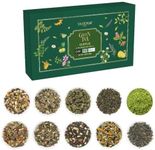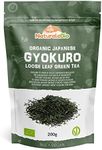Buying Guide for the Best Green Teas
Choosing the right green tea can be a delightful journey into the world of flavors, aromas, and health benefits. Green tea is known for its refreshing taste and numerous health benefits, but with so many varieties available, it can be overwhelming to choose the right one. The key is to understand the different characteristics of green tea and how they align with your personal preferences and health goals. By focusing on specific attributes such as flavor profile, caffeine content, and origin, you can find a green tea that suits your taste and lifestyle.Flavor ProfileThe flavor profile of green tea can range from grassy and vegetal to sweet and floral, depending on the type and processing method. This is important because it directly affects your enjoyment of the tea. If you prefer a more robust and earthy taste, you might enjoy a Japanese green tea like Sencha. For a sweeter, more delicate flavor, a Chinese green tea like Dragon Well might be more to your liking. Consider what flavors you typically enjoy in beverages and choose a green tea that matches those preferences.
Caffeine ContentCaffeine content in green tea can vary significantly, which is important for those who are sensitive to caffeine or looking to manage their intake. Generally, green tea contains less caffeine than black tea or coffee, but some types, like Matcha, can have higher levels. If you are looking for a gentle energy boost, a moderate caffeine level might be ideal. For those who are sensitive to caffeine or prefer to enjoy tea in the evening, look for varieties labeled as low-caffeine or caffeine-free.
OriginThe origin of green tea can influence its flavor, quality, and price. Green teas from Japan, such as Gyokuro and Matcha, are known for their rich umami flavors, while Chinese green teas like Longjing and Bi Luo Chun are often more floral and sweet. Understanding the origin can help you anticipate the flavor profile and quality of the tea. If you have a preference for a particular flavor or are interested in exploring the cultural aspects of tea, consider trying teas from different regions.
Processing MethodThe processing method of green tea affects its flavor, aroma, and nutritional content. For example, Japanese green teas are typically steamed, which preserves their bright green color and fresh, grassy flavor. Chinese green teas are often pan-fired, resulting in a more mellow and nutty taste. If you prefer a fresher, more vibrant taste, you might opt for steamed teas. For a more roasted, complex flavor, pan-fired teas could be a better choice. Consider what type of flavor experience you are seeking when choosing based on processing method.
Health BenefitsGreen tea is renowned for its health benefits, including antioxidants, vitamins, and minerals that can support overall well-being. Different types of green tea may offer varying levels of these benefits. For instance, Matcha is known for its high antioxidant content because the whole leaf is consumed. If health benefits are a priority for you, consider researching which types of green tea are most aligned with your health goals, such as boosting metabolism, improving focus, or enhancing relaxation.















